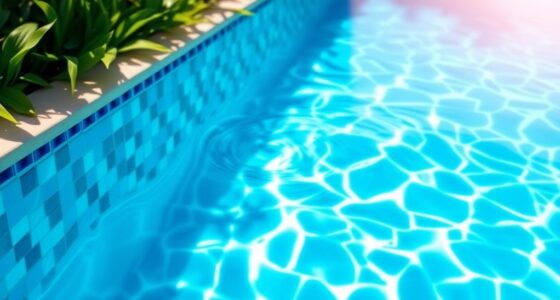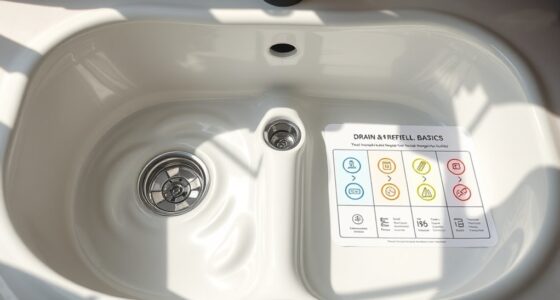Keeping your cold tub clean is crucial for safety and enjoyment. Regularly test your water’s pH and sanitizer levels, and drain and refill the water every 1-2 weeks. Use the right sanitizers like chlorine, bromine, or mineral systems, and make sure you’re applying them correctly. Clean your filters, replace worn parts, and inspect your equipment often. If you want simple tips to maintain a sparkling, safe cold tub, you’re about to discover how to do it easily.
Key Takeaways
- Regularly test water pH and sanitizer levels to maintain safe, clear, and hygienic water.
- Drain and refill the tub every 1-2 weeks to prevent buildup of bacteria and contaminants.
- Clean filters every 2-4 weeks and replace them every 6-12 months for optimal filtration.
- Use appropriate sanitizers like chlorine, bromine, or ozone, following manufacturer instructions carefully.
- Store chemicals safely away from children, and inspect equipment regularly to ensure proper functioning.
Why Cleanliness Matters in Your Cold Tub

Keeping your cold tub clean is essential because bacteria and mold can quickly build up, posing health risks. Proper sanitation depends on maintaining the right balance of pool chemicals and water pH. When you don’t add the correct chemicals, bacteria can thrive, leading to skin infections or other illnesses. Regularly testing and adjusting the water pH guarantees the chemicals work effectively and prevents algae growth or cloudy water. If the pH gets too high or low, sanitizers become less effective, risking contamination. Consistent cleaning and chemical adjustments keep your cold tub safe and inviting. Using an air purifier to improve indoor air quality can also help reduce airborne pollutants and maintain a healthier environment around your setup. Remember, a well-maintained water pH and proper use of pool chemicals are your best defense against germs, making your cold tub a safe and enjoyable experience.
Understanding the Basic Components of Cold Tub Sanitation

To effectively sanitize your cold tub, you need to understand its basic components involved in maintaining water quality. These include the filtration system, chemical feeders, and circulation pumps. Proper equipment maintenance ensures these components function correctly, supporting stable water chemistry. Water chemistry involves balancing pH, sanitizer levels, and alkalinity to prevent bacteria growth. Here’s a quick overview:
| Component | Purpose |
|---|---|
| Filtration System | Removes debris and contaminants |
| Chemical Feeders | Dispense sanitizers and pH adjusters |
| Circulation Pumps | Maintain consistent water movement |
| Testing Kits | Monitor water chemistry accurately |
Understanding these parts helps you keep your cold tub safe, clean, and enjoyable. Regular inspection of equipment components ensures optimal performance and safety.
Daily Maintenance Routines for a Sparkling Cold Tub
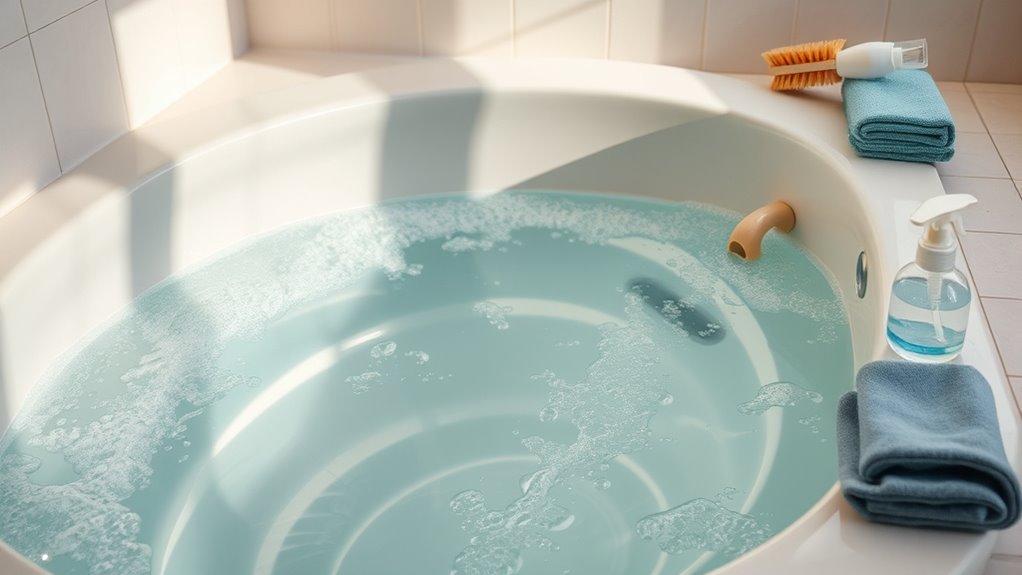
Keeping your cold tub clean starts with a regular drain and refill schedule to prevent buildup. Make sure to use proper cleaning techniques to remove any residues, and check the water quality daily to guarantee it’s safe and clear. Staying consistent with these routines keeps your tub sparkling and ready for use. Incorporating regular water testing helps ensure optimal water conditions and enhances overall sanitation.
Drain and Refill Schedule
Regularly draining and refilling your cold tub is essential to maintain clean, safe water. Setting a consistent drain schedule helps prevent the buildup of bacteria and impurities. Typically, you should drain and refill your tub every 1 to 2 weeks, depending on usage and water quality. Keep an eye on your refill timing; don’t wait too long between refills, as stagnant water can become unsafe. Establish a routine that fits your schedule and stick to it. Using a timer or reminder can help ensure you don’t forget. Properly managing your drain schedule and refill timing keeps your cold tub fresh, hygienic, and ready whenever you want to enjoy it. Regular maintenance is key to a safe, clean experience. Additionally, being aware of the water quality and ensuring that your filtration system is functioning properly can further enhance the cleanliness and safety of your cold tub.
Proper Cleaning Techniques
Maintaining a clean cold tub isn’t just about draining and refilling; daily cleaning routines play an essential role in keeping the water sparkling and safe. To control algae buildup, wipe down the interior surfaces regularly with a soft cloth or sponge, paying attention to corners and crevices. Use a gentle, non-abrasive cleaner designed for cold tubs to remove any dirt or residue. This also helps with odor elimination, preventing unpleasant smells from developing. Rinse thoroughly after cleaning to ensure no cleaning agents remain. Consistent cleaning reduces algae growth, keeps the water clear, and maintains a fresh scent. Remember, a quick daily wipe is more effective than infrequent deep cleans and helps keep your cold tub inviting and hygienic. Regional resources can also provide additional guidance for maintaining your specific type of cold tub.
Water Quality Checks
How can you guarantee your cold tub’s water stays clean and safe for each use? Regular water testing is essential to monitor its quality. Use test strips or a testing kit to check pH levels and sanitizer content daily. Proper chemical balancing is key to preventing bacteria growth and maintaining clear water. If the pH is too high or low, adjust it with pH increasers or decreasers. Ensure sanitizer levels—such as chlorine or bromine—are within the recommended range. Consistent testing and balancing keep the water hygienic and inviting. By making water quality checks a daily routine, you prevent buildup of contaminants and extend the life of your cold tub while ensuring a safe, revitalizing experience every time. Additionally, understanding juice detox side effects can help you manage your health while maintaining your tub.
Choosing the Right Sanitizing Products for Your Cold Tub

Choosing the right sanitizing products is essential for keeping your cold tub safe and clean. You need to contemplate different sanitizer types, guarantee they’re compatible with cold water, and follow safety tips during use. Let’s explore how to pick the best options for your tub’s maintenance. Incorporating advanced automation technologies can also streamline your cleaning process and ensure consistent sanitation standards.
Sanitizer Types Overview
Selecting the right sanitizer for your cold tub is essential to keep the water clean and safe for use. There are several options to reflect upon, each with benefits. Ozone generators are effective at eliminating bacteria and odors without chemicals, providing quick, powerful sanitation. Mineral systems use natural minerals like copper and silver to inhibit algae and bacteria, offering a low-maintenance solution. Chlorine and bromine are traditional disinfectants, but they can cause skin irritation and strong odors. Some users prefer UV sanitizers, which use ultraviolet light to kill germs directly. When choosing, consider your tub’s setup, your maintenance routine, and any sensitivities. Combining systems, like mineral systems with ozone generators, can enhance sanitation without over-reliance on chemicals. Proper sanitation practices are crucial for maintaining safe and hygienic cold tub use.
Compatibility With Cold Water
When it comes to maintaining a cold tub, ensuring your sanitizer works effectively in low temperatures is key. Not all sanitizers are designed for cold water compatibility, so choosing products that perform well in chilled environments is essential. Look for sanitizers formulated to stay active and effective at lower temperatures, as this helps prevent bacterial growth and keeps your water clean. Additionally, consider equipment durability—some sanitizing agents can corrode or damage your tub’s components if they aren’t compatible with cold water or are too harsh. Using the right product guarantees your system remains reliable and long-lasting. Properly matched sanitizers improve sanitation, reduce maintenance issues, and keep your cold tub safe and enjoyable for every use. As technology advances, selecting sanitizers that are compatible with 8K resolution and other high-tech features can also ensure your equipment remains in optimal condition over time.
Safety and Usage Tips
To keep your cold tub safe and effective, it’s crucial to use the right sanitizing products and follow proper safety guidelines. Choose products designed for cold water and ensure they support pH balancing to prevent corrosion or buildup. Always store chemicals in a cool, dry place away from children and pets. Proper chemical storage reduces risks of spills or accidental exposure. When selecting sanitizers, check for clear instructions and compatible pH levels. Additionally, consider the best anime movies and animated films that touch hearts for a relaxing break from maintenance tasks.
How to Properly Add and Use Disinfectants

Adding disinfectants correctly is essential to keep your cold tub safe and clean. First, measure the proper disinfectant concentration as recommended by the manufacturer, usually expressed in parts per million (ppm). Use a clean test kit to verify the levels regularly. Pour the disinfectant into the water, ensuring even distribution. It’s vital to maintain the correct contact time, which allows the disinfectant to effectively neutralize bacteria and viruses. Typically, this means letting the disinfectant sit in the water for a specified period, often 15-30 minutes, without using the tub. Always follow the manufacturer’s instructions for both concentration and contact time, and avoid overshooting these measures to prevent skin irritation or equipment damage. Properly adding disinfectants ensures your tub stays hygienic and safe for use.
Tips for Cleaning and Replacing Filter Systems
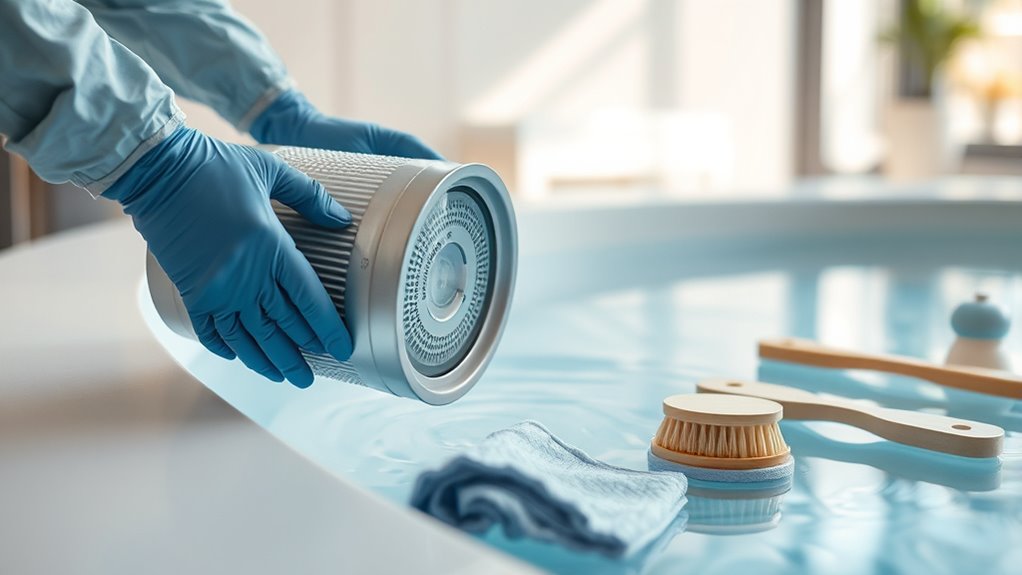
Regularly cleaning and replacing your filter system is essential for maintaining a hygienic and well-functioning cold tub. Proper filter system maintenance prevents dirt buildup, algae growth, and reduces bacteria. To keep your filter working efficiently, follow these tips:
- Clean the filter every 2-4 weeks, depending on usage, to remove debris and prevent clogging.
- Replace the filter entirely every 6-12 months, based on manufacturer recommendations and signs of wear.
- Rinse the filter thoroughly after cleaning and ensure it’s completely dry before reinserting it.
Adhering to the recommended replacement frequency and routine cleaning helps keep your cold tub sanitary and prolongs the life of your filter system.
Troubleshooting Common Sanitation Problems
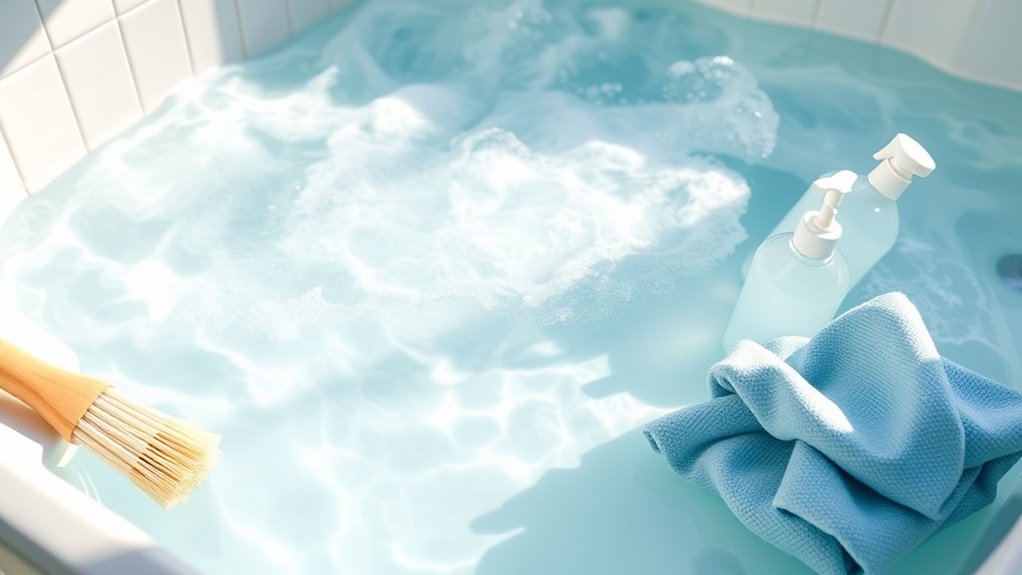
When sanitation issues arise in your cold tub, quick and effective troubleshooting can prevent larger problems and guarantee safe, clean soaking. First, check for chemical imbalances, such as low sanitizer levels or incorrect pH, which can lead to bacteria growth and cloudy water. Adjust the chemicals accordingly and retest. If water remains dirty or cloudy despite proper chemical levels, inspect your equipment for malfunctions—like a faulty circulation pump or filter. Ensure filters are clean and functioning correctly, and replace any broken parts. Sometimes, equipment malfunctions disrupt proper sanitation, so maintaining and repairing your system is essential. Addressing these issues promptly keeps your cold tub safe and enjoyable, preventing bacteria buildup and ensuring consistent water clarity.
Long-Term Care and Preventative Measures

Maintaining your cold tub’s cleanliness over time requires proactive strategies to prevent sanitation problems before they start. Regular winter maintenance ensures your tub stays in top shape, even during cold months. To keep things running smoothly, focus on these key measures:
Proactive winter maintenance keeps your cold tub clean and in peak condition year-round.
- Check and adjust the chemical balance weekly to prevent algae and bacteria growth.
- Drain and thoroughly clean your tub at least once every few months, especially before winter storage.
- Maintain proper filtration and circulation, ensuring the system runs efficiently during colder seasons.
Frequently Asked Questions
How Often Should I Completely Drain and Refill My Cold Tub?
You should drain your cold tub and start a refill schedule at least every 4 to 6 weeks. This drain frequency helps prevent bacteria buildup and maintains water quality. Regularly replacing the water guarantees your tub stays clean, safe, and inviting. Keep an eye on water clarity and odor, and if they worsen, consider draining and refilling sooner. Consistent maintenance keeps your cold tub in top condition for your enjoyment.
Can I Use Household Cleaning Products on My Cold Tub?
You shouldn’t use household chemicals on your cold tub because they might contain harsh ingredients that can harm the tub’s surfaces or interfere with water chemistry. Using these products compromises tub safety and could cause irritating residues or damage. Instead, stick to specially formulated spa or tub cleaning products designed for aquatic environments—they’re safe, effective, and guarantee your cold tub remains clean without risking your health or equipment.
What Are Signs That My Sanitation System Isn’T Working Properly?
You’ll notice signs like a foul odor, cloudy water, or visible biofilm buildup on surfaces, indicating your sanitation system isn’t working properly. If the water isn’t clear despite regular cleaning, check for chemical imbalances that can hinder sanitation effectiveness. These issues suggest your system needs adjustment or maintenance. Regular testing and cleaning help prevent biofilm buildup and maintain proper chemical balance, ensuring your cold tub remains safe and enjoyable.
How Do Temperature Fluctuations Affect Sanitation Effectiveness?
Temperature fluctuations can devastate your sanitation efforts like a storm tearing through calm waters. When water temperature varies, it disrupts the chemical balance and water stability, making sanitation ineffective. Cooler temps slow down sanitizer action, while warmer temps create perfect conditions for bacteria to thrive. To keep your cold tub clean and safe, maintain steady temperatures, monitor chemical levels, and guarantee water stays stable—don’t let chaos reign in your pristine oasis.
Is Professional Maintenance Necessary for Optimal Sanitation?
Yes, professional maintenance isn’t always necessary for ideal sanitation, but it can help guarantee your cold tub stays clean. You should regularly perform DIY cleaning, checking chemical balance and sanitizing surfaces. Professionals can fine-tune chemical levels and spot issues early, saving you time and effort. While DIY is effective for routine cleaning, occasional professional maintenance guarantees your tub remains safe and properly sanitized, especially if you notice persistent problems.
Conclusion
Keeping your cold tub clean isn’t just about appearance—it’s essential for your health. Regular sanitation reduces bacteria and mold, lowering the risk of infections. Did you know that bacteria can multiply rapidly in unclean water, doubling every 20 minutes? By following simple maintenance routines and choosing the right products, you can enjoy a safe, invigorating soak every time. Stay consistent, stay safe, and your cold tub will reward you with clean, crystal-clear water.


